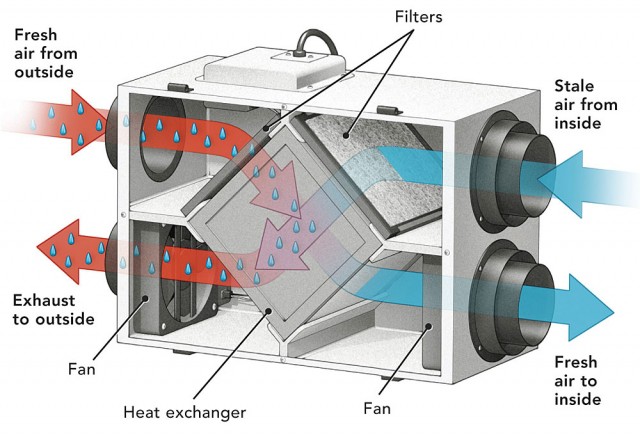The Ultimate Guide to HRV Setup in Residential Spaces
Wiki Article
Just How Heat Recovery Ventilation Enhances Indoor Air Top Quality and Reduces Power Costs
Heat Recovery Ventilation (HRV) systems play a vital role in boosting interior air top quality while all at once decreasing energy expenses. By efficiently exchanging stagnant indoor air with fresh exterior air, HRVs assist preserve perfect moisture and decrease pollutants. In addition, their capacity to recuperate heat from outbound air minimizes the stress on heating and cooling systems. As power costs remain to rise, comprehending the complete capacity of HRV systems comes to be progressively important for home owners and organizations alike.Understanding Heat Recovery Ventilation Solutions

Heat recovery ventilation (HRV) systems play a vital role in boosting indoor air top quality, especially in modern, energy-efficient structures. These systems are developed to move heat from the outbound stagnant air to the inbound fresh air, thus lessening power loss while maintaining optimal temperature level degrees inside. HRVs include a warm exchanger, followers, and ductwork, facilitating the continuous flow of air. By eliminating interior toxins and introducing fresh air, HRVs help to balance humidity levels, stop mold and mildew development, and lower allergens. The efficiency of HRV systems lies in their capability to recover up to 80% of the warm from the tired air, promoting power conservation while guaranteeing a healthy and balanced indoor environment. Their assimilation is important in accomplishing sustainable living methods.
The Significance of Indoor Air Top Quality
Indoor air quality (IAQ) is a crucial variable affecting the wellness and health of passengers in any environment. Poor IAQ can result in various wellness concerns, consisting of breathing problems, allergies, and exhaustion. Furthermore, it can intensify existing conditions such as bronchial asthma. Factors adding to reduced IAQ include pollutants from interior sources like cleaning up agents, mold, and poor air flow. Preserving excellent IAQ is vital for promoting a safe and comfortable living or working space. Effective techniques to improve IAQ involve regular surveillance of air top quality, correct air flow systems, and decreasing using harmful materials inside. By focusing on IAQ, individuals can assure a healthier atmosphere that cultivates performance and general top quality of life.Power Performance Conveniences of HRV Systems
Numerous house owners and structure supervisors are progressively recognizing the energy effectiveness advantages of heat healing ventilation (HRV) systems. By transferring warmth from exhausted interior air to inbound fresh air, HRV systems markedly lower the energy required for heating & cooling. This process lessens dependence on conventional a/c systems, bring about reduced power costs. In addition, HRVs help preserve a well balanced indoor environment, avoiding extreme home heating or cooling demands. The capacity to recoup approximately 90% of the warm from outbound air likewise supports sustainability efforts by reducing overall power intake. Subsequently, HRV systems add not only to cost savings yet additionally to a lowered carbon impact, straightening with the expanding emphasis on energy-efficient building techniques.Installation and Upkeep Considerations
The reliable application of heat recovery air flow (HRV) systems requires mindful factor to consider of installation and upkeep aspects to assure peak efficiency. Appropriate positioning of the HRV system is necessary, as it should be installed in an area that maximizes air movement while reducing sound interruption. In addition, ductwork needs to be appropriately sized and shielded to stop power loss. Routine upkeep, including filter substitute and system cleansing, is vital to secure ideal capability and indoor air top quality. Owners must develop a regular upkeep schedule to determine and resolve potential problems prior to they escalate. Partnership with seasoned professionals throughout both installment and maintenance phases can enhance the durability and performance of HRV systems, ultimately resulting in far better interior environments and decreased power prices.
Real-World Applications and Success Stories
Exploring real-world applications of warm healing air flow (HRV) systems discloses their significant effect on indoor air quality and energy effectiveness throughout different setups. In property structures, house owners have reported better air top quality, resulting in less allergies and respiratory system issues. Schools carrying out HRV systems have noted enhanced pupil focus and reduced absence as a result of much better ventilation. Business buildings, such as workplaces and retail areas, have actually experienced lower energy expenses and enhanced worker efficiency. A business office in a pleasant climate attained a 30% reduction in power costs after installing an HRV system. These Recommended Reading success tales demonstrate that HRV innovation not only adds to healthier environments but also supplies concrete economic advantages, making it read the full info here a useful financial investment for different sectors.Regularly Asked Concerns
Can HRV Equipments Minimize Allergens in Indoor Air?
The efficiency of HRV systems in reducing interior allergens primarily depends upon their capacity to filter and exchange air. HRV Heat Recovery Ventilation. By constantly replacing stagnant air, these systems can considerably reduce irritant levels throughout indoor atmospheres
Exactly How Does Humidity Affect HRV System Performance?
Humidity considerably affects HRV system performance; high levels can bring about condensation, lowering effectiveness, while low moisture might enhance air exchange. Balancing humidity is essential for excellent procedure and maintaining interior air high quality.Are HRV Systems Noisy Throughout Operation?
HRV systems can create differing sound degrees throughout operation, relying on their style and installation. Some devices operate silently, while others may create obvious sound, specifically at higher air movement settings or when poorly preserved.What Is the Average Life-span of an HRV System?

Can HRV Systems Be Made Use Of in All Climates?
HRV systems can be made use of in various climates, yet their effectiveness might vary - HRV Heat Recovery Ventilation. In severe temperatures, adjustments or extra systems might be essential to ensure perfect efficiency and comfort while keeping indoor air high qualityReport this wiki page